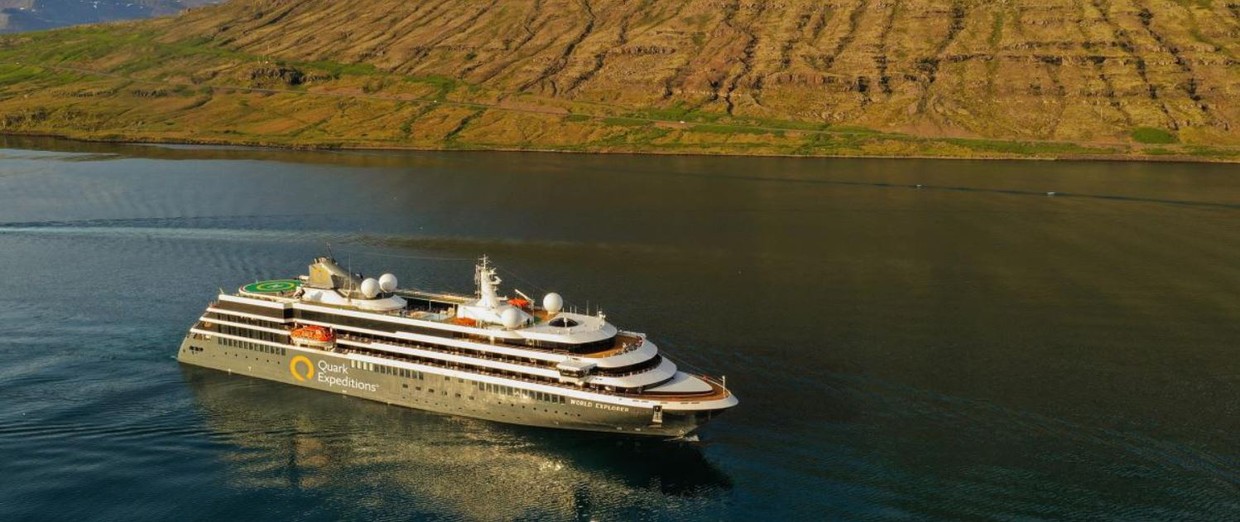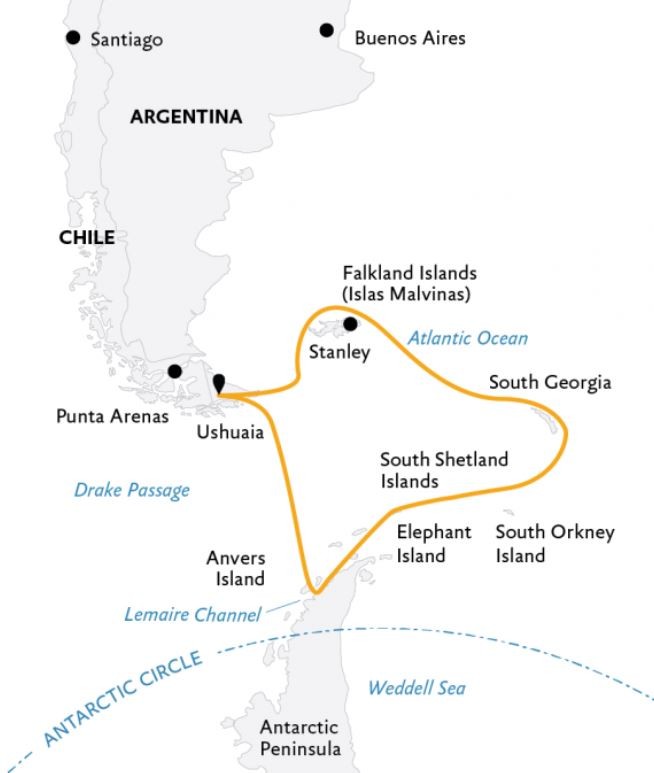2022-01-17
2023-03-31
Note: Current p/p indicative rate. Final price may change due to currency fluctuations.
The Falklands (Malvinas), South Georgia & Antarctica itinerary is the fastest way to get to the rarely visited Falkland Islands and South Georgia before stepping foot on the 7th Continent. Stroll the quaint English village of Stanley in the Falklands, wander the islands’ sandy dunes, and birdwatch at rugged seabird cliffs. In South Georgia, discover the beaches where king penguins breed – one of the highest densities of animal life on earth – and learn about the rich historical legacy of the places you visit. Both islands are known as meccas for wildlife with epic displays of animals congregating by the thousands. Then, explore the stunning Antarctic Peninsula and enter a world of ice, snow and natural wonders. Pursue your personal passions with a choice of rewarding activities and our extensive educational program.
Your gateway for this expedition is Ushuaia, Argentina. Nestled within the Tierra del Fuego archipelago, Ushuaia has a small-town feel yet boasts many shops, museums, cafés and restaurants that you can enjoy before your voyage. If you’re feeling adventurous, the nearby Tierra del Fuego National Park and Martial Glacier offer plenty of outdoor activities, such as hiking.
As you embark, the anticipation grows. Trade your land legs for sea legs, meet and greet your fellow travelers and get acquainted with your ship. Since every Antarctic adventure presents new opportunities and experiences, embarkation day is just as exciting for your Expedition Team as it is for you. On board your team will be there both to ensure your comfort and safety as well as help make your wildlife dreams come true.
Your days at sea are filled with presentations led by your Expedition Team who will prepare you for the wildlife, glaciology and history that will greet you upon your arrival. In between presentations spend time on deck looking for wildlife or chatting with your shipmates over a drink at the bar.
Upon your arrival in the Falklands (Malvinas), your camera will get its first real workout capturing the abundant wildlife and rugged feel of this sub-Antarctic region. The archipelago contains two main islands, East Falkland and West Falkland, which you will explore during daily excursions. Stanley, also known as Port Stanley, is often a favored landing site, as the town offers a unique British outpost feel, complete with eclectic charm. You’ll be free to explore, grab a pint at the local pub or visit the cathedral and museum. In terms of wildlife, the archipelago is home to Magellanic, gentoo and southern rockhopper penguins. If you’re lucky, you may even spot king penguins here as well! You can expect to see black browed albatross, plus two endemic bird species—the flightless Falkland steamer duck and possibly the elusive Cobb’s wren. Your expert education team will be sure to enrich your understanding of the local flora and fauna, making the most out of your time in the Falklands.
Sailing southeast to South Georgia, you’ll officially enter Antarctic waters once you cross the Antarctic Convergence, an invisible biological boundary encircling the continent. This meeting of oceans, where the cold Antarctic waters mix and mingle with the warmer waters of the Indian, Pacific and Atlantic Oceans, helps nourish the abundance of krill that attracts whales, seals, and birdlife to this part of the world. Your Expedition Team will notify you when you cross this invisible yet important line, and also look out for the seabirds and marine life that frequent the area.
This remote, mountainous island was a popular stop for many historic Antarctic expeditions and was once a haven for hunting whales and seals. Today, island wildlife populations are rebounding, but you’ll still see remnants of old whaling stations and other abandoned outposts. One significant and historic site is the grave of the great explorer Sir Ernest Shackleton. You can visit his grave at the settlement of Grytviken, which is also home to an old whaling station, plus a museum, gift shop, church and small research station. Although South Georgia’s history is an important attraction to the island, its incredible densities of wildlife make it truly memorable. Each landing you make on South Georgia, often referred to as the Galapagos of the Poles, will open your eyes to the wondrous lives of new, enthralling creatures. One day you may see colonies with hundreds of thousands of pairs of king penguins waddling on a beach, and the next, you may visit another beach blanketed with hundreds of fur or elephant seals. The grasses, mountains and beaches of South Georgia all play an important role in the breeding and survival of different species on the island. This fragile and interwoven relationship is something your Expedition Team will instill in you during your time here.
Say goodbye to the king penguins, as your next destination is Antarctica! Your days at sea are filled with presentations, workshops, and social activities led by your Expedition Team. If conditions allow, we may attempt landfall on the South Orkney Islands, our first official stop in Antarctica.
The most common reaction upon reaching the White Continent is a sense of reverence and awe. The experience is beyond words, since few places are as untouched and enduring as Antarctica. You will discover that Antarctica is a land of extremes. At one moment you’ll be overcome with a feeling of complete isolation and silence, and at the next moment you’ll be inspired by nature as a calving glacier crashes into a brilliant blue sea or a penguin waddles by to inspect your footwear. Your Expedition Team will take care of you at each excursion, whether you are Zodiac cruising, visiting a historical site or consorting with penguin colonies. Chinstrap, Adélie and gentoo penguins are found here, along with Weddell, fur, crabeater and leopard seals. During Zodiac cruises, keep an eye out for Antarctic whales such as minkes, as you may get a chance for an intimate experience with these majestic animals. Each day and each excursion will present a new collection of creatures to entertain you and keep your camera busy. As exciting as the Zodiac excursions and landings are, perhaps you’ll treat yourself to an extra-special Antarctic experience by partaking in an optional paddling excursion (at an extra cost) or cast reason aside and jump into Antarctic waters for the Polar Plunge!
After more than two weeks of endless wildlife encounters, your journey home begins. Crossing the Drake is your unofficial rite of passage, completing your Antarctic adventure. Enjoy your final moments celebrating with your fellow shipmates. The busy, populated world awaits your return, so savor the silence of the sea as long as you can.
After breakfast aboard the ship, it is time to part ways and say goodbye to your Expedition Team. Airport transfers will be provided for those departing on the first homeward flights. Other guests will be transferred to town.
Embracing the unexpected is part of the legacy – and excitement – of expedition travel. There are no guarantees that we can achieve everything we set out to accomplish. A measure of flexibility is something all of us must bring to a voyage. There are nearly 200 recognized sites in the Antarctic Peninsula and South Shetlands and the places mentioned above may be changed to others equally as interesting.

Vessel Type: Expedition Ship Length: 126 metres Passenger Capacity: 176 Built: 2017 Distinct and comfortable, refined and roomy—these attributes and more describe World Explorer. Not only will it be among our fastest ships, it will also be one of our finest, with six tiers of deluxe accommodation. The personal space is exceptional. Every cabin has either a private walk-out or Juliet balcony for direct ocean views. World Explorer also delivers plenty of public areas to unwind in after a day outdoors, including the glass-domed Observation Lounge for quiet contemplation and full skyline views, the Explorer Lounge for a drink and a chat, and the library for more intimate relaxing and reading. Presentations and discussions are facilitated in a dedicated lecture theatre. Health and wellness facilities feature an outdoor running track, a small gym and a sauna, plus a spa with change rooms, showers and lockers. For the active adventurers, add-ons include kayaking, camping and stand-up paddleboarding. Blending high design with total functionality, World Explorer is all set to be your home away from home on the seas. Cabin: - All cabins have exterior views and private bathroom facilities - TV and safe in every cabin - Individual temperature controls - Electrical supply: 220v Aboard: - Chef-prepared meals (all meals and daily snack included) - One dining room with unreserved seating - Bar staffed by a professional bartender serving a selection of soft drinks, juices, liquors, spirits, beer and wine, which can be charged to your shipboard account - Comfortable lounge area for reading or relaxing with a cup of coffee - Observation decks for spotting wildlife and enjoying the ever-changing polar landscape - Polar library stocked with a large collection of polar books, and games - Gym - Pool & sauna - Spa facilities and wellness program - Lecture theatre - Polar Boutique - Ship-to-shore satellite communications with email and wireless Internet access Activities: - Zodiac Cruising (included) - Kayaking (additional charge) - Camping (additional charge) - Standup Paddleboarding (additional charge)
• Hiking in the polar regions differs from your typical trail experience. Here, in a tree-less terrain, you are the tallest figure on the landscape as you walk over spongy tundra, crusty snow or sandy beaches in remotes parts of the Antarctica. • The Polar Plunge is scheduled once during each voyage. Throughout the journey, the Expedition Leader and Captain constantly monitor conditions in order to choose the optimal time and location. The Polar Plunge sometimes takes place onshore or, in many cases, from the gangway or Zodiac. • Zodiacs are used for transferring you ashore, transporting your luggage when necessary and for taking you ocean-level cruising among icebergs, whales and seabirds. During the expedition, you will visit remote and isolated sites that are accessible only by Zodiac.
